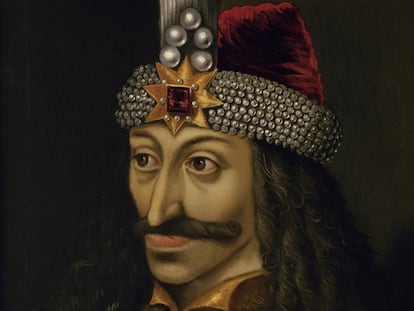Hunting Dracula in Dublin
The Bram Stoker Festival offers intense experiences for the fans of the king of vampires and his creator, as it traces the footprints of both in the Irish capital

Following Dracula’s bloody trail in Dublin — a city more associated with Joyce, Beckett or Michael Collins — may seem strange to some. The obvious thing would be to hunt him down in his Transylvanian lands, or perhaps in the English settings of his story (Whitby and London). But it is in the Irish capital, the city where Bram Stoker (1840-1912), the literary father of the vampire, was born and spent his youth, and where he forged many of his literary obsessions, where one of the essential events for fans of the dark count and the novel that breathed immortal life into him is held every year.
Attendants to the Bram Stoker Festival (which has been taking place for a decade and whose latest edition, which ended on Monday, appropriately coincided with the Halloween festivities) were able to enjoy all kinds of intense experiences related to the king of the undead and his creator. Among them, a very interesting deconstructive session of Dracula (1897) by the writer’s great-grandnephew, Dacre Stoker, author of a sequel of the novel and specialist in the work of his ancestor; a dramatized reading of the first chapters of the book at the prestigious Abbey Theatre; and the performance of Revenant, a disturbing monologue about vampirism.
There were also some exciting tours of some places related to the life and work of Bram Stoker, such as the Trinity College, where he studied; the gothic and highly evocative Marsh Library, where he researched witchcraft and apparently found his first map of Transylvania; or the cemetery where his people were buried, and where the tomb of Sheridan Le Fanu is located, “the invisible prince of Dublin” and author of Carmilla, Dracula’s Austrian female precedent. Also, conferences, debates, screenings and activities for all audiences, such as parades (this year, the traditional Macnas Parade revolved around a bone-collecting wolf woman), cosplaying and the Stokerland fair, where families were able to enjoy vampiric chills together (riding a merry-go-round by the Saint Patrick’s Cathedral cemetery, buying peat incense to scare away evil spirits, a Vlad the Impaler figurine or a garlic grater, face painting and more). In short, this is the great fangs-tastic festival, as someone cleverly dubbed it.
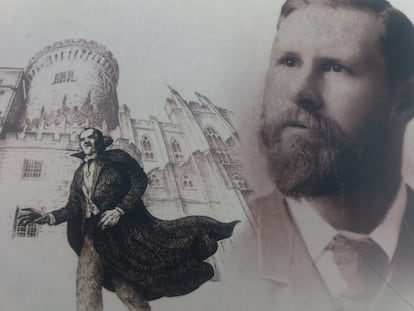
Walking the wonderfully melancholic streets of Dublin while one follows a dark Bram Stoker itinerary, with each shadow turned into a black cape, is a shot of emotions akin to a good transfusion. One of the best aspects of the festival experience, organized by the city council, is the variety of people one meets in the activities: curious people, specialists, romantics and hardcore geeks. A good place to make long-term friendships under the motto “blood is life”; kindred spirits with whom to debate whether Dracula’s dwelling was inspired by Bran Castle in Transylvania or Slains Castle in Scotland.
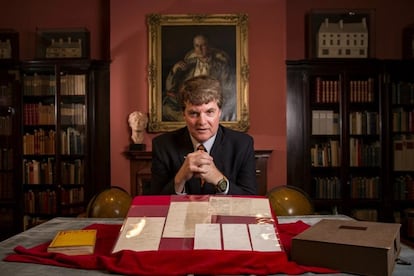
Dissecting Dracula
Dacre? Dacre Stoker! “In the flesh,” he replies. We are in the courtyard of Dublin Castle, under the shadow of the Record Tower, the only one that remains from the medieval fortress. Dacre recalls that we met in 2009 when he published his forceful — sex and violence galore — sequel, Dracula the Un-dead. Since then, his draculian activity has been increasing exponentially. He currently leads thematic tours (“of fact and fiction,” he points out) through all the settings related to the vampire, Transylvania, Whitby... he also films documentaries, writes and is one of the managers of his ancestor’s intellectual property, as well as one of the main researchers of his legacy (and a regular at the festival).
He looks fit. He is 65 years old but, like Bram, he has been a top athlete, an Olympic pentathlete. We talk about The Last Voyage of the Demeter, a recent movie based on the seventh chapter of Dracula, the count’s journey by ship from Varna to England. He finds the film phenomenal and terrifying. Then he sends me to see something that his wife found on the other side of the courtyard: a plaque explaining that Bram Stoker worked for years in the castle as a public official (from 1866 to 1878, before he permanently moved to London), illustrated with a portrait of the writer and a drawing of Dracula, the first direct encounter with the count here in Dublin. He is depicted with a cape and tailcoat, à la Bela Lugosi, and disturbing fingers with long nails, with the castle in the background.

One of the forms of entertainment these days is to find references to Dracula or vampires around the city, where blood-colored posters and flags of the festival abound and where, by association, everything else seems to be dyed red. That all the bookstores in the city would prominently display editions of Dracula was to be expected; not so much, however, to find a bar called Bite of Life and another one called Quick Bite, as well as a Multi Bite store; or a small sculpture of a vampire in the permanent exhibition on Yeats at the National Library of Ireland (always a must-see). Or a taxi driver who has read Dracula three times and quotes passages as we head to Clontarf to see the Stoker family house, where the writer was born and spent his youth. Not to mention the guy with pointy vampire ears (fake, we hope) sitting nonchalantly at the talk Bram and Beyond: The Irish Supernatural.
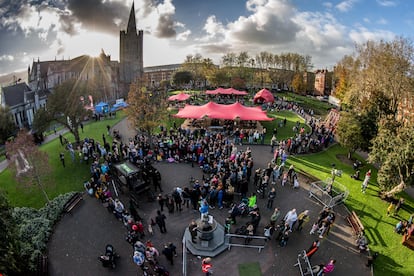
In that very well attended talk (about two hundred people), a special live edition of Three Castles Burning — a popular podcast about the history of Dublin — the historian Donald Fallon and the editor Brian J. Showers from Swan Press (accompanied by the actress Kathy Rose O’Brien, who read passages from the books that they mentioned), discussed the importance of Ireland’s fantasy and horror tradition and its influence on Stoker and Dracula. Although the author wrote his most famous novel in England (where he moved in 1978 after marrying Oscar Wilde’s ex-girlfriend), he took from his land, and from Dublin, many things that contributed to his creation, a fact that David J. Skal noted it in his “secret biography” of Stoker, Something in the Blood. These include supernatural creatures from Celtic folklore, popular demon figures and the tradition of the black carriage driven by an undead, which appears to have made the entire journey from Sligo to Borgo Pass.
Fallon and Showers also highlighted the influence of the macabre stories that his mother used to tell young Bram Stoker (bedridden due to an illness until he was seven years old) about the cholera plague that struck Ireland in 1832. They linked Stoker’s work with that of authors such as Le Fanu, Dorothy Macardle or Katharine Tynan, from whom O’Brien read the beautiful lines “Was she a girl or was she a ghost?” as a baby burst into tears at the back of the room, as if Lucy Westenra was still hungrily wandering around Hamstead.
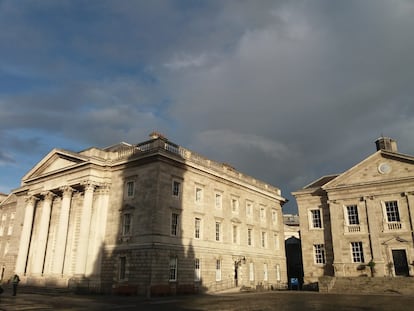
One of most interesting activities was Dacre Stoker’s interactive literary workshop, Dissecting Dracula, in which a dozen participants — mostly female — sat around several tables decorated with candles and cobwebs to analyze and discuss the material about the novel that the scholar (wearing a shirt printed with different covers of Dracula) gave us: copies of pages from Stoker’s diary and handwritten notes for his work, with important keys to understanding his creative process, including the exhaustive work of documentation and some plot changes (including the title, which went from The Un-dead to Dracula).
Among the texts, about which Dacre asked us questions as if it was an exam (fortunately, one could copy the Canadian girl sitting beside him), there were exact train schedules for Harker’s trip, characters that did not make it to the final manuscript (there was a detective), location changes (Whitby instead of Dover), news related to the plot (the shipwreck of the Russian ship Dimitri in Whitby, 50 exhumations due to suspicions of vampirism in England), considerations about the volcanism of the area of Dracula’s castle (the novel had to end with an eruption), annotated maps, pages about the vampire’s properties and powers, Transylvanian superstitions, necromancy... in short, a delight. There is even a note about the death’s head hawkmoth, Acherontia atropos, for feeding Renfield, Dracula’s lunatic servant (the same moth that appears lodged in the throat of one of the victims of the killer in The Silence of the Lambs).
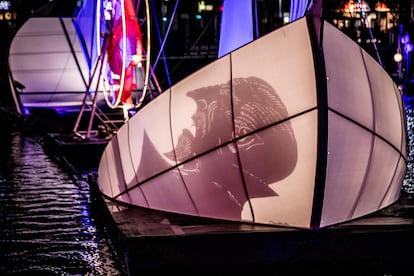
A legend on the stage
On Saturday, a group of twenty people — again, mostly women— waited under the Trinity bell tower for the Bram Stoker Tour to begin. We were a motley group that included an American couple with cowboy hats in the style of Quincey Morris, the Texan from Dracula; a French woman, Katia, a contributor to vampirisme.com who told us about the vampire fair that will take place in France in 2024 (impossible not to think of Armand, from Interview with the Vampire); a boy with green hair and the Romanian writer Daniela Stoian (D. S. Crowe), author of a trilogy about Dracula that starts with I, Dracula. Only Van Helsing and the stakes were missing. The tour, guided by a student from the university, took us to the premises of the College Historical Society, to which Stoker belonged, and to learn about aspects of his life at the Trinity.
At the festival, Stoker’s interest in theater was especially highlighted (he worked as a critic, and one of the most important relationships of his life, which was decisive in the creation of Dracula, was the one he had with the actor Henry Irving, one of the most famous of his time). The performances of Revenant, an award-winning play with touches of black comedy in which a filmmaker faces the disturbing presence of an actor who ends up being a vampire, was another of the highlights of the festival. The show is a monologue created and directed by Stuart Roche and performed splendidly by Patrick O’Donnell, who plays both the director of a zombie movie set in the Great Irish Famine (1845-1849) and its protagonist, the mysterious Vardell. The setting of the performance, the underground stage of the Smock Alley Theatre— the oldest theater in Dublin — adds a spark of excitement. You feel as if you were in the bowels of Carfax Abbey with the count’s coffins.
The other great theatrical event was Dracula: A Journey Into Darkness, a staged reading of the first six chapters of the book by the actor Andrew Bennett, with the voice of Barry McGovern as the count. “The staging is very performance-oriented, with music from traditional songs and sound effects,” the director (and well-known actress) Joan Sheehy explains to me over a cup of tea. “The main instruction I gave the actors was not to try to show the horror too soon.” In Chapter 1, Jonathan is confident and amused by the fear and superstitions of the local people. In Chapter 2, Dracula is a charming, curious and knowledgeable host. It is until chapters 3 and 4 that the count’s guest begins to get truly scared.
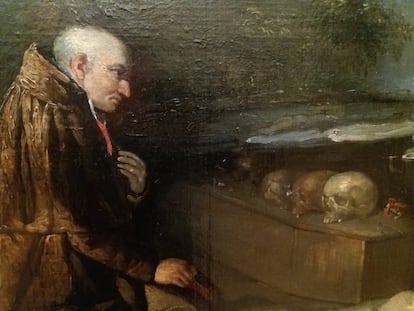
An activity at the National Gallery (a tour with two female vampires who question modern art) revealed another unexpected presence of Dracula in the form of the count, a terrifying but aristocratic individual with the air of Nosferatu that appears in the macabre painting Figures by a Coffin (1840) by Daniel Macdonald, kneeling before a coffin on which several skulls can be seen. The visit to the museum offers another surprising encounter, this time with a wonderful painting of a medieval couple saying goodbye on the stairs of a tower. He could be the voivode Vlad; she could be the love that will redeem him via Coppola after oceans of time. They are the characters of The Meeting on the Turret Stairs (1864), a romantic watercolor by Frederick William Burton which, due to its fragility, is only exhibited for one hour on Thursdays and another on Sundays. It is easy to evoke in its captivating atmosphere the end of the count reduced to ashes under the knife of Jonathan Harker, the vampire with an unusual expression of final peace on his face. Meanwhile, his castle stands out in the reddish sky as the evening light illuminates each stone of its broken battlements. A nice farewell from Bram Stoker, Dublin and Dracula.
Sign up for our weekly newsletter to get more English-language news coverage from EL PAÍS USA Edition
Tu suscripción se está usando en otro dispositivo
¿Quieres añadir otro usuario a tu suscripción?
Si continúas leyendo en este dispositivo, no se podrá leer en el otro.
FlechaTu suscripción se está usando en otro dispositivo y solo puedes acceder a EL PAÍS desde un dispositivo a la vez.
Si quieres compartir tu cuenta, cambia tu suscripción a la modalidad Premium, así podrás añadir otro usuario. Cada uno accederá con su propia cuenta de email, lo que os permitirá personalizar vuestra experiencia en EL PAÍS.
¿Tienes una suscripción de empresa? Accede aquí para contratar más cuentas.
En el caso de no saber quién está usando tu cuenta, te recomendamos cambiar tu contraseña aquí.
Si decides continuar compartiendo tu cuenta, este mensaje se mostrará en tu dispositivo y en el de la otra persona que está usando tu cuenta de forma indefinida, afectando a tu experiencia de lectura. Puedes consultar aquí los términos y condiciones de la suscripción digital.

